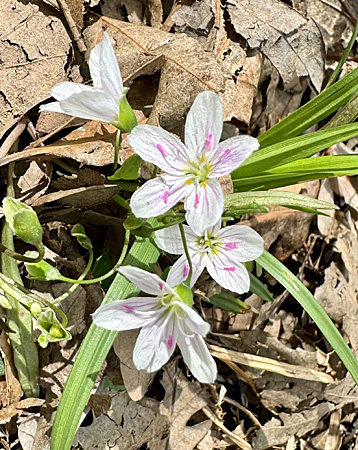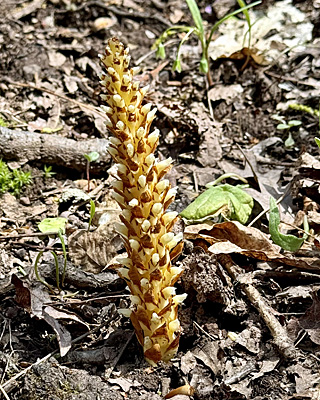A group of 13 wildflower enthusiasts braved the wind at Ball’s Bluff Regional Park on Saturday, April 13 to learn about our local native fauna from renowned naturalist John DeMary. John began with a brief description of the Park, detailing the clearing of trees at the Civil War Centennial and later purchase by NOVA Parks to preserve land that had been earmarked for development.

Spring Beauty.
Photo by Karen Hoffman
At Ball’s Bluff, the White Oak is the most productive tree in the forest, housing and feeding a variety of animals as well as plants. In a mature forest, only 30 percent of sunlight reaches the ground. Therefore, it is important for spring ephemerals to bloom before the oaks and other trees leaf out.
We walked down the Interpretive Trail lined by Spring Beauties, Common Blue Violets and Early Saxifrages. John introduced us to the Lawrence Newcomb method of plant identification. We determined the flower type, plant type, leaf type of several flowers and then identified them using the guide book. As we followed the trail around the field, we saw Mayapples, Greater Burdock, and large patches of Spring Beauties.
We reached the cliff’s edge and headed down the orange trail towards the water. We saw several more spring ephemerals, some already past bloom but many flowering in the patches of sunlight filtering through the trees. Rue Anemone, Bluets, pussytoes, Shooting Stars, Star Chickweed, Bloodroot, Common Yellow Violets and Dutchman’s Breeches lined the path.

American Cancer-root.
Photo by Karen Hoffman
As we approached the water, we were greeted by swaths of Virginia Bluebells. Volunteers have been pulling invasive Garlic Mustard in this area for over three years, and the results are stunning! We walked along the Potomac River through patches of Wild Ginger and Virginia Waterleaf. Trout Lily, Jack-in-the-pulpit and Squirrel Corn were growing among the native ground cover.
John led us up the cliff trail back into the forest where we saw Harbinger of Spring, white violets, Twinleaf, Toadshade Trillium and a patch of Fragile Fern. He pointed out an interesting parasitic plant, American Cancer-root, which grows only on oaks and does not produce its own food. Near the cemetery, we saw a patch of RattlesnakeWeed. We followed the orange trail back to the parking lot. The Spring Beauties there were now wide open to the sun, awaiting pollinators that are only active when the temperature reaches 50 degrees. We had an enjoyable and educational outing, learning about many native wildflowers along with other native plants and trees.


Leave a Reply
Your email is safe with us.